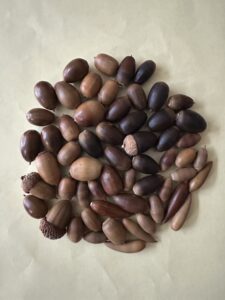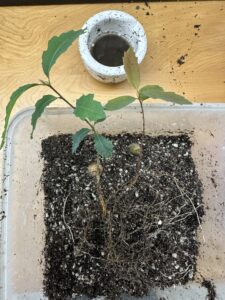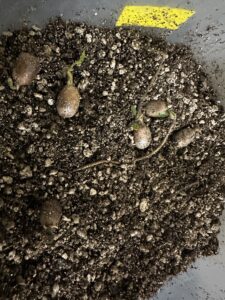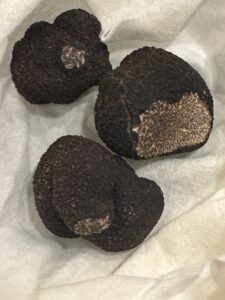Progress report for FW24-005
Project Information
California’s native oak population has declined because of long drought, goldspotted oak borers and other diseases, negatively impacting the local ecosystem. Some species, such as Engelmann Oak, have fallen into threatened status. While many acres of agriculture land are left idle due to high cost of farming and low produce prices, reforestation is not occurring naturally. Seedlings from oak acorns need deliberate effort to survive the initial years, including irrigation, protection from wild animals and weed control. We design a new agroforest system to bring income to farmers and locally produced delicacy to consumers and replenish the native oak forest. Our project will test the feasibility of introduction of black truffle fungi to roots of native oak seedlings and observe their development in local soils, which is the first step of setting up truffle cultivation with native oak trees. The black truffle fungi will provide extended root network for oak trees and help them fend off diseases. The black truffles produced from the replanted trees will become a high value crop and bring income to farmers, thereby making the reforestation effort financially sustainable with many benefits to the ecosystem. We will communicate with farmers and agriculture professionals nationwide and statewide with our results and host outreach activities in our local communities. We will also educate students and future farmers about the new agroforest system for truffle production.
- to optimize protocol and test the successful colonization of black Perigord truffle (Tuber Melanosporum) in the roots of native oak seedling after inoculation with truffle spores in the greenhouse condition during the first year.
- to work out soil amendment and irrigation schedule for planting the seedling in the ground and monitor the presence of truffle micro in the roots during the second year.
- to perform outreach to raise awareness of saving oak forest, to introduce a black truffle as a new local commodity among farmers, conservationists, chefs and consumers and educate students and next generation farmers about the sustainable agriculture practice.
| Date | Activities | Team member |
| July-Dec 2024 | Acorn germination, truffle spore prep, inoculation to roots of oak seedlings, greenhouse growth of seedling | PI (Charlie Chen) |
| Jan-June 2025 |
continuing growing of seedlign in greenhouse, observation of truffle in the root tip under microscope, Soil samples, field prep |
PI and TA (Gregg Cady) supports with soil sampling and field prep |
| July-Sept 2025 |
conduct first field day (July) continue monitoring truffle mycorrhizae formation in roots of seedlings planting successfully inoculated seedlings in the field |
PI and TA support irrigation setuo |
| October 2025-June 2026 |
manage the planted trees, record their growth compared to control; continue monitoring truffle mycorrhizae formation in root in the soil in the soils; report final results, conduct outreach activities. conduct second field day (June) |
PI and TA |
Cooperators
- - Technical Advisor
- - Producer
Research
The project is carried out on the grounds of our farm in Alpine CA.
- Choice of native oak trees
The survey of oak trees on our property was done in consultation with Fred Roberts, a Rare Plant Botanist from California Native Plant Society. There are Engelmann Oak (Quercus engelmanii), Coastal Live Oak (Quercus agrifolia) California scrub oak (Q. berberidifolia) and hybrids of them, clustering on the old streambed with many big trees died or dying. We collected mature acorns from these trees in October before they fall into ground. It is possible that different species of oaks have different inoculation efficiency by black truffles. We kept some acorns in a refrigerator for one month in case they need stratification to geminate, but we found that is not necessary for the native oaks as acorns kept at room temperature geminate ready once they are placed in a moisturized environment.

I have communicated with Dr. Charles Lefevre, the President and founder of New World Truffieres, who specializes in truffle cultivation and the controlled inoculation of oak and hazelnut seedlings for 20 plus years. We are in a stretch of coastal California land with Mediterranean climate and well-drained soil suitable for black truffle (Tuber melanosporum) cultivation. He pointed out that although Engelmann Oak has not been tried for truffle culture, it and Coastal Live Oak belong to a subgroup of oak trees as the European Holy Oak (Quercus ilex), which is the most common used oak tree for black truffle cultivation They would tolerate moisture condition in the roots, which is required for truffle growth. Native oak trees are best adapted to the soil, altitude and climatic conditions of our farm. They should have a growth advantage over European Holy Oak. Using Engelmann Oak and Coastal Live Oak will help restore the native oak population and avoid introducing non-native species to the local ecosystem. There are reports of black truffle (Tuber melanosporum) successfully colonized some indigenous Chinese and Mexican oak trees and promoted oak seedling growth (see citation list). So we should have a good chance of success with our native oaks.
- Method of inoculation:
The acorns are selected by a submerging/floating test in water and all floating acorns are discarded. Before germination, acorns will be disinfected with 30% bleach for 15 minutes, 70% alcohol for 30 seconds, and rinse with sterile water for 30 seconds. Perlite and vermiculate media (1:1) plus 1 part of water were placed in filter-vented boxes and autoclaved in a pressure cooker for 30 minutes to kill existing fungi in them. The sterile condition gives truffle fungi the first comer competitive advantage over other fungi in the environment. The first fungi the roots exposed to is the black truffle. It took acorns 2-4 weeks to geminate and form seedlings.
We obtained fresh Perigord truffle ascoma (fruitbody) from a farm in Oregon and freeze-dried truffle power (truffle spores can survive for years in dried condition) from Australia. The identity of the truffles was confirmed as Tuber melanosporum by PCR. Twenty grams of truffles were chopped into small pieces and grinded into a fine paste with a mortar and pestle to form a spore suspension in 20 ml water. The spiky shaped spores were observed under a microscope.
One month old seedlings were root-dipped in the truffle spore suspension and planted in autoclaved perlite, vermiculite, peat moss mix (1:1:1) in nursery pots in a greenhouse for the next 11 months, which is a semi-sterile condition away from soils.

Survey of root will be done under a dissection microscope, looking for the tips of the rootlets with a swollen or inflated shape, and mycorrhizae formation, a hairy morphological characterization unique for black truffle Tuber melanosporum. A rate 0f 35% to 50%
- Planting into soils at the farm
The 1 year old colonized seedlings will be planted to fenced selected sites on the farm. The soils at planting site will be adjust to pH of 7.5−8.0 with lime to inhibit other fungi species in the soil and provide advantage for the black truffle fungi in a competition with local fungi in the soils for colonizing the root system.
Proper irrigation in the month of summer when there is scarce precipitation is important for survival of oak seedlings and development of truffle mycelium. We will install a sprinkler system with a controlling timer for each oak seedling. We will determine the optimal watering schedule based on the soil moisture measurement in each month and observe the effect on plant growth. Root survey for fungi mycorrhizae will be done every 3 months to make sure they are present. Samples of root tip will be collection in the immediate periphery of the tree with care not to damage the root system.
During the second year, we will measure the height, branch number and stem diameter of truffle inoculated oak trees and compare with control groups every six months, looking for evidence that the symbiotic relationship benefit oak trees.
At the conclusion of the project, we will have the findings if the truffle mycorrhizae are consistently present and expand with the growing tree root network. The identity of mycorrhizae will be molecular check by Polymerase Chain Reaction (PCR) with species specific primers. Although the truffle fruitbodies will take 4-8 years to appear under good orchard management practices, we will continue to monitor the progress of truffle mycorrhizae in the roots by microscopic and molecular techniques instead of blindly waiting.
We found that native oaks acorns germinate readily without stratification treatment. To keep them for later use, it is still better to keep them in a fridge because they may lose moisture content quickly at room temperature and fail the floating test, but when kept in a closed bag at room temperature, they can start to germinate spontaneously.
Research outcomes
Education and Outreach
Participation summary:
We will report our results from inoculation of black truffles in Engelmann Oak and other native oaks, and the potential effect on tree health. It will give our results national and international exposures and spread the new concept of using native oak trees to achieve afforestation and truffle production at the same time. Our Technical Advisor Gregg Cady will use his connection and capacity at Resource Conservation District to promote the benefit of growing truffles in native oak trees and lead outreach program with local farmers. We will organize Field Days on our farm inviting farmers and agriculture professionals in Japatul Valley and neighboring communities, with the involvement of students and interns to showcase the different species of native oak trees on our farm and the process to inoculate black truffle to oak tree seedlings. We will give tours of the greenhouse and the field. We plan to host one event after the first year with the inoculated seedlings planted in the field and one at the end of the project. We will distribute printed handouts highlighting the high value of black truffles and the environmental benefit of restoring native oak forests. We will conduct surveys at the event using SARE survey forms. We will also participate in events of local Farm Bureau, Resource and Conservation District and San Diego Farm and Nursery Expo to distribute our printed flyers to reach hundreds of local farmers and agriculture professionals. We will provide seedlings and advice for farmers who consider setting up truffle orchards on their land. We will also go to Good Food Showcase in San Diego County and Fresh Idea Organic Expo in Los Angeles to reach the consumer side of audience. Mr. Donnie Dyer, a local agriculture teacher and an advisor for Future Farmers of American will invite us to teach truffle culture to his students. Through World Wide Opportunities on Organic Farms (WWOOF) program we have hosted more than 20 interns in the past years. We also have student interns from Cal State University at San Marco to work at our farm. Christina Simokat, who leads the University service learning program, will serve as our liaison to help our outreach effort to pass on findings of this project to more students. PI will give lectures to the students on growing fungi. We plan to produce PowerPoint presentations, handouts, brochures, flyers, posters to use and distribute at meetings and events. We will have a feature article about our farm in San Diego Edible magazine which has both paper and online publication. It will help us to introduce local produced truffles to other farmers and consumers. We will also build social media presence such as website and Instagram. We will send our flyers and handouts to local Indian reservations and provide assistance if they want to look into this opportunity.
We worked closely with staff at Resource Conservation District San Diego to plan our outreach activities once we have our results. We attended San Diego fungi festival to connect with people interested in truffle cultures. We spoke with chefs about possible productions of local black truffles.


